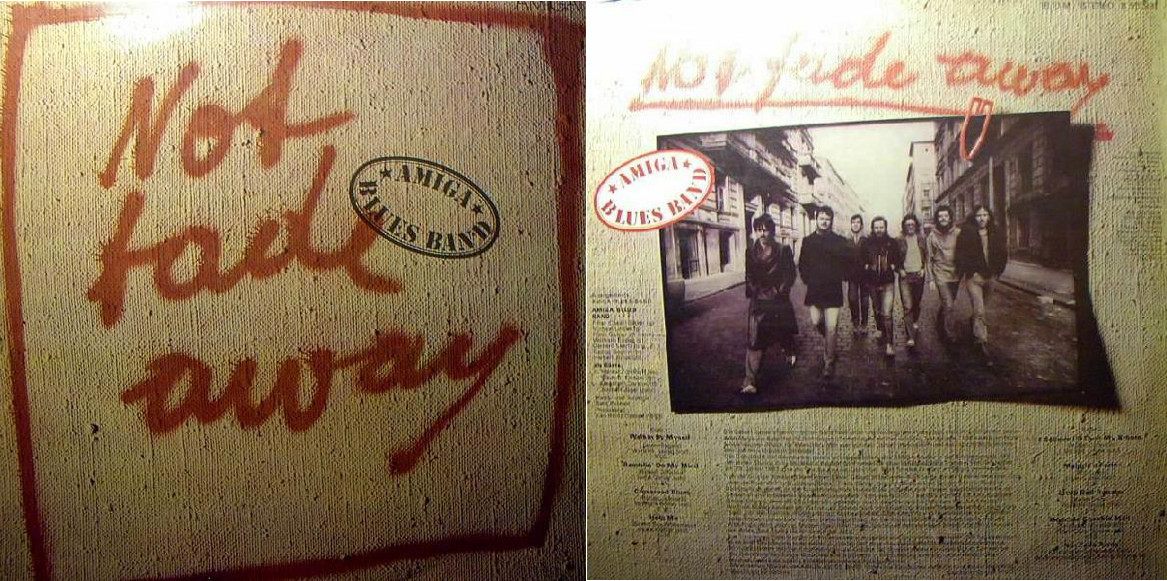The Blues Scene in the GDR started in the late 1950s, gaining official recognition in the 1960s and peaking by the 1970s. But it wasn’t until the 1980s that the cultural power of the Bluesers was turned to political ends – this was the point at which the scene became strongly associated with the independent grassroots peace movement.

Sadly, the protagonist of the East Berlin Series, Martin, was a little too old to be an archetypal Blueser – while others were hitchhiking around the country, going from festival to festival and from gig to gig, clad in jeans and green parkas, carrying all their worldly possessions in home-made bags sewn from folk-kitsch tapestries (Hirschbeutel) – Martin would have been at home, looking after his infant daughter Katrin. But he would have enjoyed the album put together by various musicians who’d been chosen by the official record Label Amiga to showcase Blues music in the GDR.
To many westerners the album, Not Fade Away, is surprising: no home-grown songs here – all are classic Blues tunes, sung in English. It is partly this insistence on singing in English that made the Communist Party so suspicious of the scene, and goes some way to explaining why it took so long for the music to be officially accepted. One can see how musicians in the GDR felt an affinity with the early Blues players of inter-war America – a shared sense of using music as an ephemeral escape from the restrictions of general life. On the other hand the Blues represented solidarity with a culture oppressed by the capitalist-aggressor USA – a useful argument when trying to persuade a conservative minded apparatchik to give you a licence to play in public! In any case, the years of dialogue with Party officials, not to mention the continuous demand from consumers, paid off in 1983. In that year Amiga decided it wanted the Blues.
Some of the best Blues acts in East Germany were chosen to be part of the impromptu Amiga Blues Band, indeed, most are still well known names: Peter “Cäser” Gläser from Karussell and Renft, Frank Gahler and Michael Linke from Monokel, Georgie Gogow played with City and Wolfram “Bodi” Bodag led Engerling – a band which is still producing cutting edge music today.
All the bands mentioned above are worthy of posts in their own right, but for the moment I’ve chosen this album to showcase the talent for Blues that was to be found in the GDR.
The Amiga Blues Band and their album had their debut at the second Rock für den Frieden (Rock for Peace) festival in January 1983. The festival, hosted by the Committee for the Entertainment Arts and the Communist youth organisation FDJ at the Palace of the Republic in Berlin, was held over several days and attracted some of the best artists in the GDR. But over the following few years the event lost its appeal: becoming more and more closely associated with the establishment rather than with the music. The Communist party had to find new ways to appear attractive to young people.
Unlike the Rock für den Frieden festivals, the Bluesmessen (Blues Services) held in churches were organised at a grassroots level and never diminished in popularity. The best known Bluesmessen took place at the Samariter Church in Berlin-Friedrichshain. Originally the intention was to hold Blues concerts in churches since these were the only meeting places not controlled by the state – and therefore the only places where musicians could play in public without a licence. Rainer Eppelmann, the protestant Church’s youth minister for the Berlin district of Friedrichshain agreed to host the concerts on condition that they would be interspersed with religious texts. In the end this was a good move which helped provide a measure of protection from state interference, since it allowed the church to claim that the events were church services rather than concerts.
The Bluesmessen were very popular, featuring both well known (including Engerling and Monokel) and fresh acts – the concerts at Eppelmann’s church peaked in 1983 with over 7000 concert-goers before the church leadership closed them down under state pressure. More Bluesmessen and other music concerts were held in churches in Berlin and around the country, notably in the Erlöserkirche in Martin’s neighbourhood. (If you want to visit the Samariterkirche and the Erlöserkirche have a look at the tour guides: Cops and Squats and Martin’s Kiez.)
I’ll leave you with an excerpt form the cover text, written by Karl-Heinz Ocasek:
Further Reading
- Blues in der DDR: Kulturelle Symbolik und politische Interpretation (in German) by Michael Rauhut
- Eastblues (in German) information on the scene and the bands by a Blueser.
